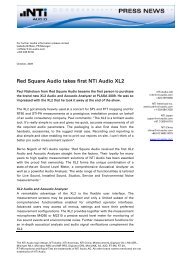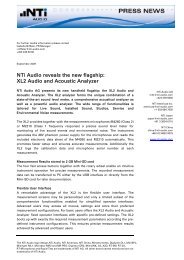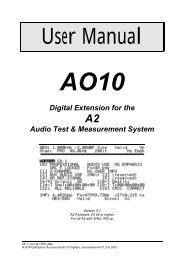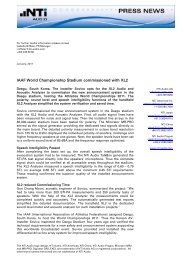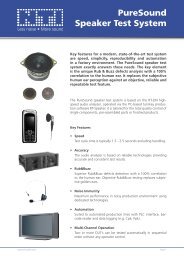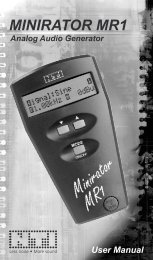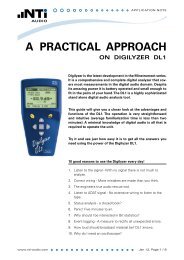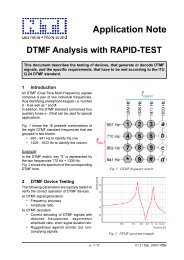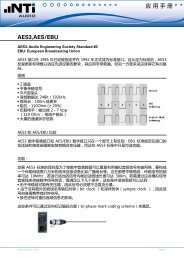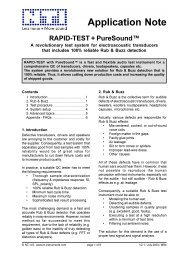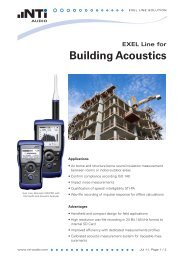Minilyzer ML1 User Manual
Minilyzer ML1 User Manual
Minilyzer ML1 User Manual
Create successful ePaper yourself
Turn your PDF publications into a flip-book with our unique Google optimized e-Paper software.
Measurement Functions<br />
To enter the 1/3 rd OCTAVE SPL mode (Fig 3.20), select 1/3 rd OCT. -><br />
SPL in the measurement functions submenu.<br />
Arrow readout: The arrow readout displays the frequency and<br />
the level of the 1/3 rd octave band that it points to. The arrow<br />
automatically points to the highest level in the 1/3 rd octave spectrum,<br />
or, alternatively may be controlled manually.<br />
Arrow Mode: The arrow readout may be moved manually to a certain<br />
specific 1/3 rd octave band.<br />
• Select the arrow mode field and press the enter key.<br />
• Move the arrow to any frequency by using the left/right keys.<br />
run/pause: The 1/3 rd octave spectrum may be freezed.<br />
• Select the run/pause field and press the enter key.<br />
• The1/3 rd octave spectrum is freezed.<br />
• The arrow mode or zoom symbol may be selected for the detailed<br />
read out of the 1/3 rd octave spectrum.<br />
• At selecting any other field the measurement will be continued.<br />
• Press the enter key again to continue the measurement.<br />
Zoom (Y-Axis): The scaling of the spectrum’s Y-axis (sensitivity) is<br />
fixed and may be adjusted manually.<br />
• Select the zoom (Y-axis) field and press the enter key.<br />
• Use the up/down keys to scroll the displayed level along the Yaxis<br />
and the left/right keys zoom out/in the Y-axis, e.g. alter the<br />
resolution of the division.<br />
Time Constant: The time constant corresponds to the integration time<br />
of the 1/3 rd octave recording. It may be set to five value: 0.2 / 0.5 /<br />
1.0 / 2.0 / 5.0 seconds. A lower time constant results in a quicker,<br />
more ‘nervous' display, whilst a higher time constant ‘averages’<br />
more samples, thus providing a more stable spectrum.<br />
Bargraph: Below the spectrum, the actual sound pressure level is<br />
indicated by a bargraph. Select the different indication ranges by<br />
moving the cursor to the left or right arrow below RNGE and press<br />
enter. The available bargraph ranges are:<br />
• 20 - 100 dB SPL<br />
• 40 - 120 dB SPL<br />
• 60 - 140 dB SPL<br />
39




